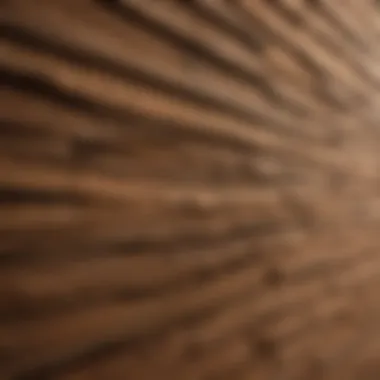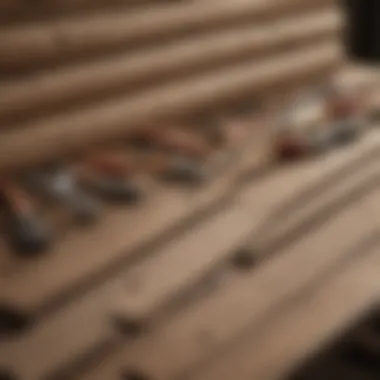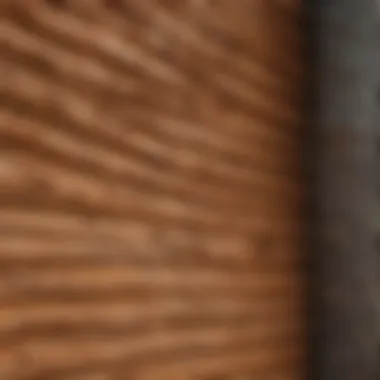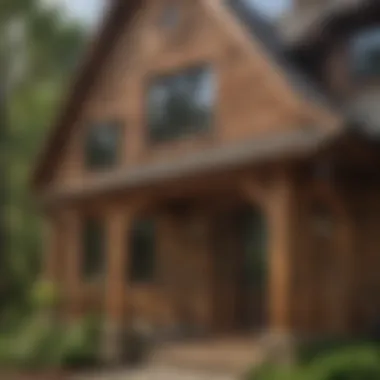A Comprehensive Guide to Cedar Shake Siding Installation


Intro
Cedar shake siding is a popular choice for many homeowners who wish to enhance their property’s aesthetic appeal, while also benefiting from its durability and insulation properties. As a product derived from cedar trees, the installation of cedar shake siding connects into broader functions like forestry practices. In this article, we will explore not just the processes involved in installing cedar shake siding, but also the underlying forestry practices related to its source. This helps understand the value of not only the material but also the sustainability efforts that surround it.
Overview of Forestry Practices
Understanding the source of cedar shake siding requires an appreciation for forestry practices. These practices are essential in determining the health and availability of cedar trees, contributing directly to the quality and sustainability of siding materials.
Importance of Foresting
Forestry plays a crucial role in maintaining the ecosystem. Proper forest management helps to prevent overharvesting, promotes biodiversity, and ensures that future generations can access timber resources. The cultivation and sustainable management of cedar forests can lead to long-term benefits for both the environment and the economy. By implementing good forestry practices, communities can harvest materials that are not only sustainable but also high-quality.
Types of Forestry Practices
There are various forestry practices that impact the cedar industry:
- Selective Logging: This involves carefully choosen trees for harvest, allowing others to thrive and continue the growth cycle.
- Reforestation: Planting new trees in the areas that have been logged ensures that the forest can regenerate.
- Agroforestry: Integrating forestry with agriculture can enhance productivity while improving soil and water quality.
Such practices not only promote stable forest ecosystems but also ensure a consistent supply of high-quality cedar for shake siding.
Best Practices for Sustainable Woodland Stewardship
The importance of sustainability in woodland management cannot be overstated. Sustainable practices ensure that the needs of the present do not compromise the ability of future generations to meet their own needs.
Principles of Sustainable Forestry
Sustainable forestry is governed by principles that promote ecological health and economic viability:
- Balance: Maintaining a balance between tree harvesting and retention.
- Biodiversity: Protecting the variety of plants and animals in forestry areas.
- Community Involvement: Engaging local communities in forest stewardship.
Techniques for Land Management
Various techniques can be employed to manage land sustainably. Some of these include:
- Controlled Burns: Helps in preventing larger wildfires while promoting the growth of new vegetation.
- Buffer Zones: Establishing zones around water sources to protect soil and aquatic ecosystems.
- Mixed Species Planting: Encouraging diverse tree species to enhance resilience against pests and diseases.
Innovative Techniques in Forestry
Advancements in technology have allowed for better management of forestry practices. Today’s innovation embraces both modern scientific approaches and traditional methodologies.
Latest Technological Advancements
With the rise of new technologies, forestry management is more effective. Drones and satellite imagery are used to monitor forest health. Additionally, data analytics helps to make informed decisions on timber harvesting.
Integrating Traditional Knowledge with Modern Science
Combining traditional knowledge about cedar forestry with scientific methods can lead to more sustainable practices. Local communities often possess invaluable insights into local ecology, which when used alongside modern science fosters improved results in forestry management.
"Understanding the intersection of sustainable practices and innovative technologies is key to maintaining healthy forests and ensuring the longevity of materials like cedar shake siding."


Prolusion to Cedar Shake Siding
Cedar shake siding is an appealing choice for builders and homeowners alike. It combines functionality with a timeless aesthetic that many desire for their properties. In this section, we will delve into the significance of understanding cedar shake siding as part of the larger process of installation.
Understanding Cedar Shake Siding
Cedar shake siding is a type of wood siding made from split logs, specifically cedar wood. The process of creating shakes gives each piece a unique texture and character. Unlike regular wood siding, which is often milled for uniformity, shakes offer a more rustic and natural look. This suit homeowners who appreciate a natural material that evolves with time. Moreover, cedar naturally resists decay, which adds to its longevity and makes it an excellent option for various climates.
Benefits of Cedar Shake Siding
One of the major benefits of cedar shake siding is its insulating properties. Cedar has a higher insulation value than other siding materials, such as vinyl or aluminum. This means homes can be more energy-efficient, leading to reduced heating and cooling costs over time. Additionally, the aesthetic appeal of cedar shakes cannot be overstated. Their natural beauty ranges from warm amber colors to silvery greys, allowing for a variety of design choices.
Furthermore, cedar shake siding is highly durable. When properly maintained, it can last upwards of three decades. This durability is complemented by its ease of repair. If damage does occur, individual shakes can be replaced without needing extensive work on surrounding materials.
Lastly, cedar shakes are an environmentally friendly option. Being a natural product, cedar is biodegradable. Homeowners can feel good knowing that they chose a material that does not contribute to landfill waste.
Common Uses of Cedar Shake Siding
Cedar shake siding is commonly used in several architectural styles. It frequently shows up in cabins and cottages, where the rustic charm complements the natural surroundings. Many suburban homes adopt this style for enhanced curb appeal. Furthermore, coastal homes benefit from cedar's resistance to moisture, making it ideal for beachside properties.
In addition to residential buildings, cedar shake siding finds its way into various commercial settings. It can add character to restaurants, shops, and other business fronts, attracting customers with its unique visual appeal. The versatility of cedar shakes allows them to adapt to many different design elements, making them a favored choice for many architects and builders.
"When it comes to siding choices, cedar shakes provide an aesthetic that enhances not just the appearance but the overall value of a property."
In summary, the introduction to cedar shake siding highlights the essential characteristics of this material. Recognizing its benefits and common uses sets the stage for a more detailed exploration into the installation process, which is a focus of the following sections.
Tools and Materials Required
The section regarding tools and materials required is crucial for the successful installation of cedar shake siding. Selecting the proper tools and materials not only streamlines the installation process but also influences the durability and aesthetics of the final product. An adequate understanding of what is needed can save time, reduce errors, and ultimately lead to a more appealing finish. In this section, we will delve into essential tools, types of cedar shakes, and supplementary materials necessary for the installation process.
Essential Tools for Installation
When embarking on a cedar shake siding project, having the right tools is vital. Here is a compile of tools essential for the task:
- Measuring Tape: To ensure accurate dimensions and proper placement of shakes.
- Level: This tool ensures that each row of siding is aligned horizontally.
- Chalk Line: A chalk line helps create straight reference lines, preventing uneven installations.
- Circular Saw: Necessary for cutting cedar shakes to size, especially in tight areas.
- Nail Gun or Hammer: Depending on preference, both tools are decisive for securing shingles.
Each tool has a specific role in achieving precision and quality in the installation. The correct choice is essential to avoid common pitfalls, such as misalignment or uneven shingles that could detract from the overall appearance of the siding.
Types of Cedar Shakes
Understanding the types of cedar shakes available is fundamental for this installation. Not only do different types of shakes offer varied aesthetics, but they also serve unique functional purposes. Below are the common types:
- Tapersawn Shakes: These shakes have a smooth surface on one side and a textured surface on the other, offering versatility in appearance.
- Hand-Split Shakes: Created by splitting cedar logs, these shakes have a rough texture, providing a more rustic look.
- Machine-Sawn Shakes: They are cut with precision and offer uniform thickness, making them easier to install but less traditional in appearance.
Each type has its own set of characteristics. Therefore, selecting the right kind depends on the desired aesthetic effect and functional capability.
Supplementary Materials Needed
In addition to tools and cedar shakes, supplementary materials are also crucial. These materials play a role in ensuring the longevity and resilience of the siding. Important supplementary materials include:
- Underlayment: Acts as a moisture barrier, preventing water damage.
- Flashing: Used around windows and doors to prevent leaks.
- Nails: Choose corrosion-resistant nails, such as stainless steel or galvanized, to ensure a strong hold in the wood.


Proper consideration of supplementary materials should not be overlooked. It can significantly preserve the integrity of the installation while augmenting its overall functionality. This enhances not only the longevity of the siding but also its protection against environmental elements.
"The meticulous selection of tools and materials can make a significant difference in the outcome of your cedar shake siding installation."
Incorporating the right tools, understanding the types of shakes, and utilizing proper materials lays the foundation for a successful installation. Readers should find themselves well-prepared and informed as they move forward on their cedar shake siding project.
Preparation for Installation
Preparation for installation is a crucial phase in the process of affixing cedar shake siding. Skipping this step or approaching it carelessly can lead to complications that may jeopardize both the installation process and the final outcome. Taking the time to prepare effectively can enhance the longevity of the siding, provide structural integrity, and ensure that the finished product looks aesthetically pleasing. Proper preparation minimizes the potential for defects, reduces waste, and allows for a more seamless application.
Choosing the Right Location
Identifying the right location for cedar shake siding installation has significant implications for the overall performance and aesthetic of the home. The placement directly affects moisture accumulation, sun exposure, and temperature fluctuations. Water drainage is paramount; avoid areas where water tends to pool. Furthermore, ensure that the surfaces to receive the shakes are dry and free from debris. Consider exposure to sunlight as well; proper placement can help reduce the risk of mold and rot, extending the life of the siding. When assessing the site, also take into account the surrounding landscape and any potential overhanging branches that could cause damage over time.
Surface Preparation
Surface preparation is non-negotiable in ensuring the success of cedar shake siding installation. Begin by cleaning the area thoroughly. Remove any old materials, grime, and loose paint from the substrate. Inspect the surface for rot or damage; any deficiencies should be remedied prior to installation. A flat and stable surface is critical, as irregularities can lead to an uneven application. For optimal results, consider installing a moisture barrier. This component is essential to prevent moisture intrusion, which could lead to decay of both the shakes and the underlying structural material. Preparing the surface meticulously will provide the adhesion and stability necessary for a long-lasting installation.
Planning the Layout
Careful planning of the layout cannot be understated. Before installation begins, sketch out the design and confirm measurements. This planning allows for adjustment before any cutting or installation takes place. Consider the visual impact of the layout; staggering seams can create a more attractive appearance and mitigate issues with water infiltration. Mark reference lines on the surface to guide placement. Ensuring consistency in the spacing of each shake and adhering to a clear pattern is necessary for achieving a polished look. Additionally, remember to account for the height of the building and the total square footage needing coverage. A methodical approach in layout planning will prove invaluable during the installation process, preventing errors and enhancing the aesthetic quality of the finished siding.
Effective preparation lays the groundwork for a successful cedar shake siding installation. Ignoring these foundational steps could result in costly repairs and unsatisfactory results.
Installation Methods
Installation methods play a critical role in ensuring that cedar shake siding is not only aesthetically pleasing but also durable over time. The right installation techniques can enhance the longevity and functionality of the siding while also preventing common issues like water damage and pest infiltration. Proper methods also contribute to a more uniform appearance and better performance against the elements. Various methods may be applied based on building design and specific environmental conditions, making it crucial to choose the right approach for your project.
Starting the Installation
Before beginning the installation of cedar shake siding, it is vital to establish a few foundational elements. The choice of a starting point can affect the entire project's outcome. It is often best to start from the bottom and work your way up, allowing for effective water shedding. Additionally, marking a level guideline helps in maintaining a straight line for the shakes as they are installed.
Ensure that the wall surface is prepped and free of any debris.
- Establish a Level Line: Use a chalk line to mark your starting point.
- Prepare the Surface: Ensure that the surface is dry and free from dirt and moisture.
- Gather Your Tools: Have all necessary tools within reach to maintain workflow efficiency.
Installing the First Row of Shakes
The first row of cedar shakes is essential, as it sets the tone for the remaining installation. The row needs to be securely fastened and properly aligned to ensure that the subsequent rows can be installed with ease. Here are some considerations during this phase:
- Use stainless steel or coated nails to prevent corrosion, especially if you live in coastal areas.
- Nail each shake down with two nails, ensuring they are oriented downward to facilitate water drainage.
- Leave a small gap between shakes to allow for expansion and contraction caused by temperature changes.
Creating Overlaps and Staggering Joints
To achieve a weatherproof seal, it is important to create overlaps and stagger the joints of the cedar shakes. This technique minimizes the risk of leaks and enhances the visual appeal of the siding. Some key points include:
- Ensure each shake overlaps the one below by at least one inch.
- Stagger the rows so that the joints do not align vertically. This prevents water from seeping through the joints.
"Proper staggering not only enhances the structural integrity but also provides a more appealing look to the finished product."


Working Around Windows and Doors
The treatment around windows and doors is crucial in preventing leaks and ensuring proper aesthetics. This requires careful cutting and fitting of shakes, which can present challenges.
- Begin by installing a flash or trim around the window or door frame for additional protection against water ingress.
- Use a straight edge to measure and cut shakes that will fit snugly around the frames. This minimizes gaps that could allow moisture to enter.
- Maintain consistent line with the siding to ensure that everything aligns correctly as you work.
Finishing Touches
Once you have installed all the cedar shakes, the final steps are vital for ensuring durability and attractiveness. These finishing touches involve:
- Caulking: Apply caulk around windows, doors, and any joints to create a water-tight seal.
- Staining or Sealing: Consider applying a protective stain or sealant to enhance the natural beauty and protect against the elements.
- Final Inspection: Walk around to check for any gaps or loose shakes before concluding the installation.
Appropriate installation methods for cedar shake siding not only elevate the home’s charm but also assure that the material offers the longevity it is known for. Engage with each step thoroughly, as overlooking details can lead to larger issues down the line.
Post-Installation Care
Post-installation care is a crucial aspect of ensuring the longevity and aesthetic appeal of cedar shake siding. Once the installation is complete, the care you invest can significantly impact both the appearance and structural integrity of the siding. Ignoring these practices may lead to deterioration or costly repairs. Establishing a care regime helps to maintain the siding and addresses issues that may arise over time.
Cleaning and Maintenance Tips
Maintaining the beauty of cedar shake siding begins with regular cleaning. For effective upkeep, consider the following tips:
- Frequency of Cleaning: Aim to clean your siding at least once a year. This will help prevent the buildup of dirt and mildew, which can degrade the material.
- Materials to Use: Use a soft-bristle brush or a pressure washer set at low pressure to gently remove debris. Avoid harsh chemicals that can harm the wood.
- Natural Cleaners: Opt for biodegradable cleaners specifically designed for wood surfaces. Solutions containing vinegar can effectively eliminate mildew without damaging the wood.
- Inspect During Cleaning: Take this opportunity to inspect for any signs of damage or wear, allowing for timely repairs.
Inspection for Damage
Periodic inspection for damage is essential. As cedar shake siding ages, it may face various challenges, including:
- Cracking and Splitting: Look for any splits or cracks in the shakes that could lead to further problems. Addressing these can prevent water intrusion.
- Rot and Decay: Inspect areas where water collects or where there is poor drainage. Any signs of rot should be dealt with immediately to maintain the integrity of the structure.
- Insect Infestation: Check for signs of insect presence, such as holes or sawdust. If detected, consult pest control professionals to handle the situation correctly.
"Regular checks can save you from more extensive repairs down the line."
Long-Term Care Strategies
For cedar shake siding to retain its beauty and durability over the years, long-term care is essential. Effective strategies include:
- Sealing and Staining: Consider reapplying a sealant or stain every 3 to 5 years. This helps protect against moisture and UV damage, securing the shakes for the long haul.
- Proper Ventilation: Ensure that the area behind the siding is adequately ventilated. This reduces moisture build-up, which can lead to deterioration.
- Avoiding Direct Soil Contact: Keep the siding above soil level. This reduces the risk of rot and ensures drainage around the base.
- Trimming Vegetation: Maintain a distance between vegetation and the siding to avoid moisture retention and shade, which can lead to mildew.
Taking these long-term measures will enhance the performance and lifespan of your cedar shake siding. It's essential to engage in consistent care and regular checks to maximize your investment.
Culmination
In this article, we have explored the multifaceted aspects of installing cedar shake siding. The conclusion serves as a crucial component, synthesizing the essential insights and knowledge shared throughout. Understanding the significance of cedar shake siding encompasses not only its aesthetic appeal but also its practicality in application. For both professionals and DIY enthusiasts, knowing how to properly install this type of siding ensures durability and enhances the overall value of the property.
Summary of Key Points
The key points of the guide can be summarized as follows:
- Understanding Cedar Shake Siding: The beauty and functionality of cedar shake siding highlight its value in the construction industry.
- Tools and Materials: Adequate preparation is critical. The right tools and high-quality materials ensure a successful installation process.
- Preparation Techniques: Preparing the workspace and choosing the correct location are vital steps before the actual installation begins.
- Installation Methods: Knowledge of various installation methods can significantly affect the final appearance and durability of the siding.
- Post-Installation Care: After installation, proper maintenance is needed to prolong the lifespan and maintain the aesthetics of the cedar siding.
Further Resources and Readings
To deepen your understanding of cedar shake siding and its installation, consider these resources:
- Wikipedia on Cedar Shake Siding
- Britannica: Wood Siding
- Reddit Community Discussions
- Facebook Groups for DIY Side Projects
These sources contain additional tips, visuals, and community support which can enhance your knowledge and assist you in practical applications. Engaging with such materials may also provide innovative ideas and solutions for your own projects.















